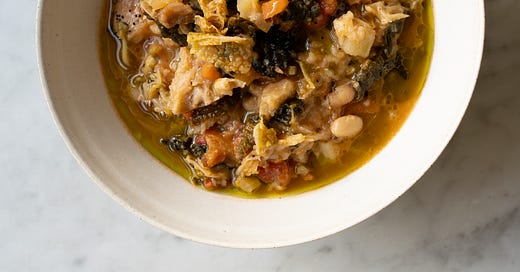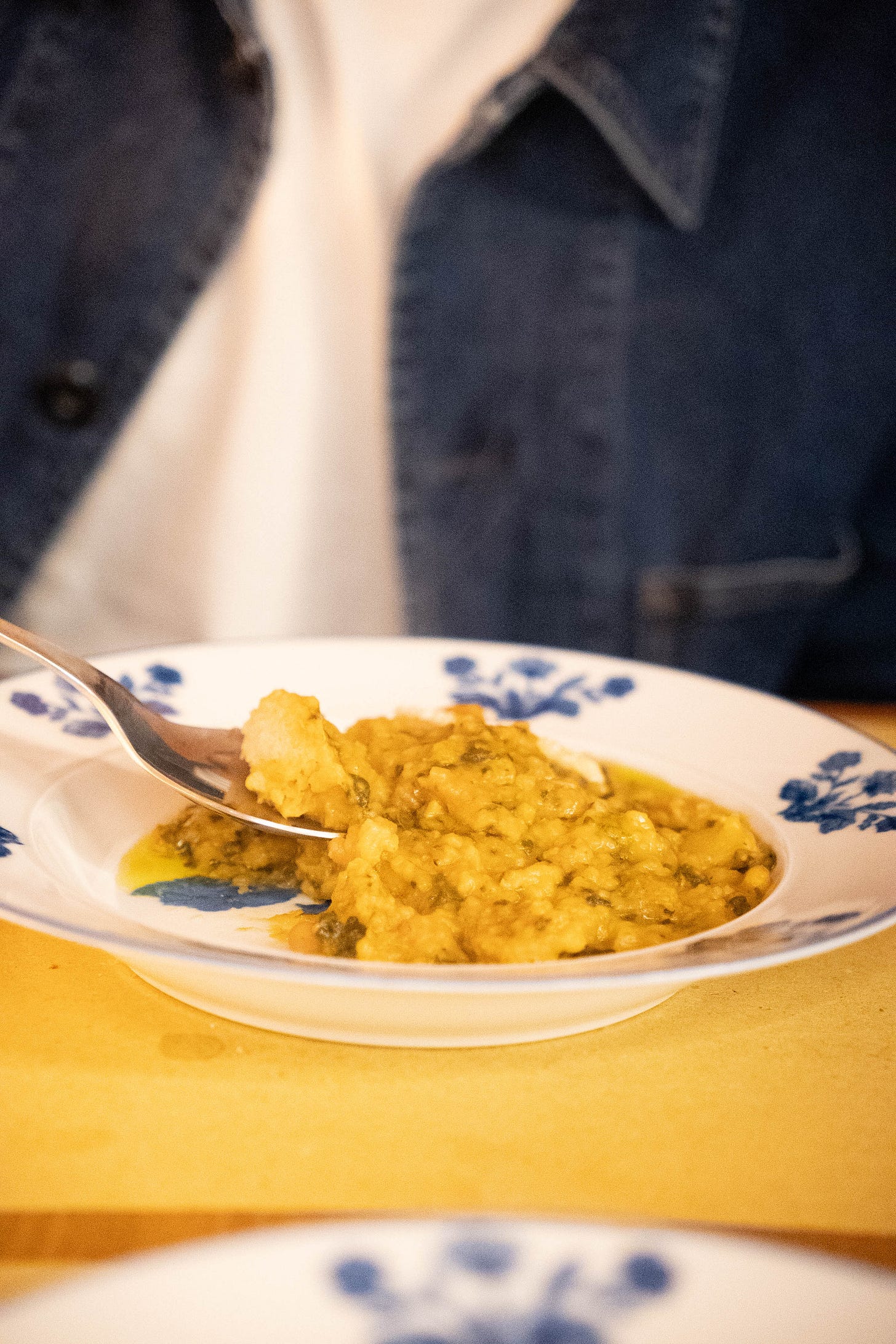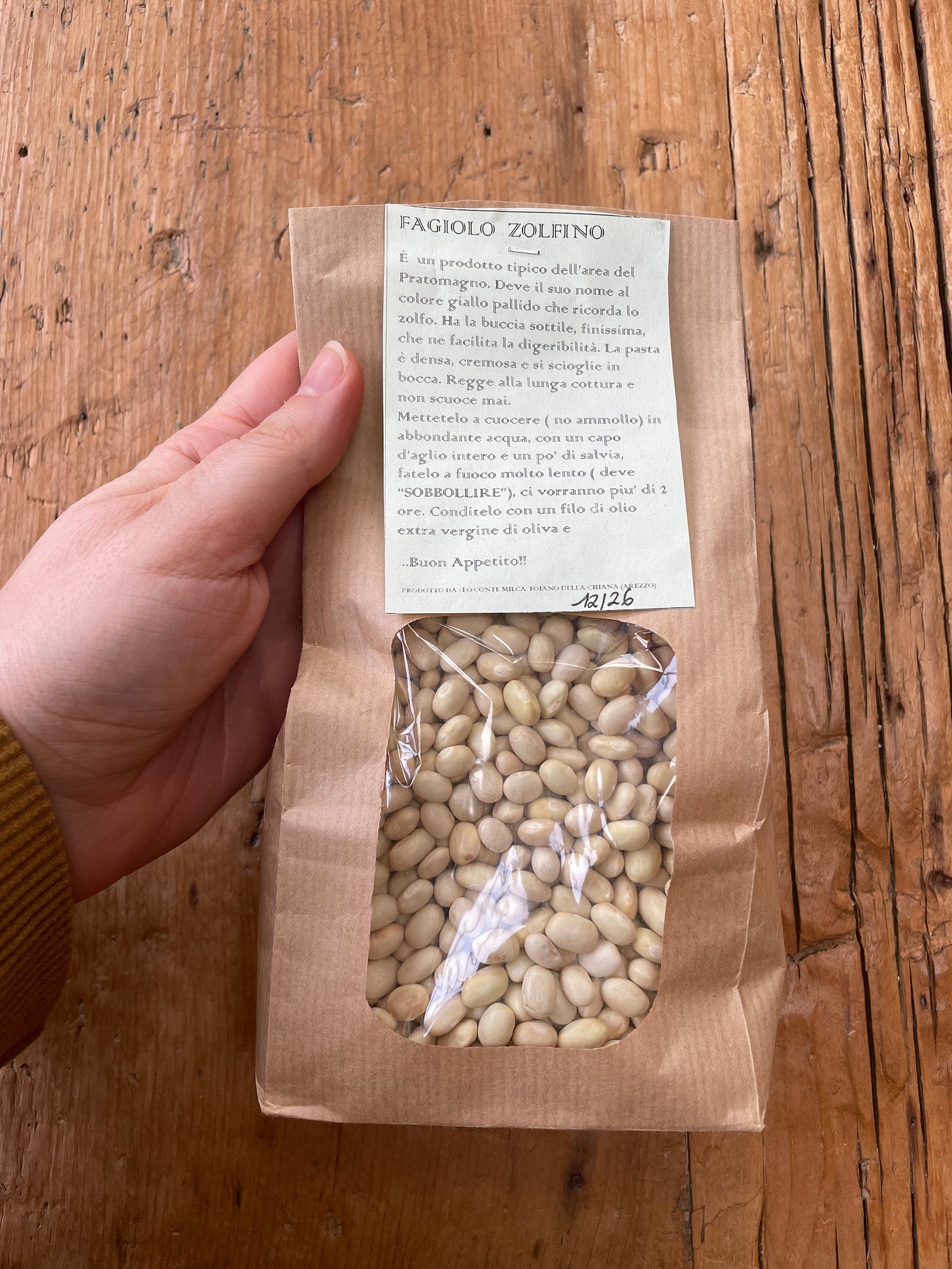The humble joys of Ribollita
A Tuscan "cucina povera" staple I have been craving (and making) this week
I have been spending the week mostly in bed, coughing up my lungs with whatever nasty virus everyone seems to have caught this January. Feeling so wretched made me want to reach out for some healthy, wholesome comfort food, and the inspiration came from a recent trip to Umbria and Tuscany over the holidays.
Ribollita, literally meaning "reboiled," is a rustic Tuscan soup that was born out of necessity, as a peasant dish. Traditionally made to use up leftover bread and vegetables, it embodies the ingenuity of cucina povera (“poor cuisine”), where nothing goes to waste. Like many popular dishes, you can find many variations of it online, but the cornerstones of this soup are Cannellini Beans (half pureed, half whole), the Cavolo Nero + Cabbage combo and stale bread – preferably Tuscan bread, which is saltless (although I used leftovers potato sourdough I had lying around, and it was equally delicious, so long as you use decent bread).
It is meant to be prepared ahead (ideally the day before), to allow the soup to soak and break down the stale bread, to be consumed and re-heated the next day (hence the name). I’m not going to sit here and tell you it’s as straightforward as your box-standard minestrone. But it’s definitely not difficult to make either, it just requires a little time and patience, and the reward is totally worth it. Plus, it easily keeps in the fridge for 3-4 days, and the flavour only keeps getting better.
A Note on beans
Another note before we begin – and that’s on beans. I’ll be the first to admit, I am not a huge bean lover. A lot of it has to do with gassy bellies, some of it with the consistency itself, plus the faff of the whole soak-overnight business. My world has been rocked by the discovery of Zolfino beans – a small, delicate, and very niche variety typical of the area of Pratomagno (spanning from Florence to Arezzo). The beauty of these particular beans is that they don’t require pre-soak, and the skin is so thin and tender, that it is practically undetectable when cooked. They hold the consistency really well, they are hard to overcook and they are more digestible. All of this to say, I came home from our trip to Umbria with three bags of them (and I would urge you to keep an eye out for them on your next trip to Florence), so this is what I used in the recipe, although the traditional recipe calls for much more widely available Cannellini beans.
Whether you want to be a purist about it or use canned beans, that’s entirely up to you, no judgement here! I’ve catered for both options in my recipe.
Ribollita
(Serves 4–6)
Prep time: 20 minutes (plus overnight soaking if using dried beans)
Cook time: 2 hours (with dried beans) or 1 hour (with canned beans)
Resting time: Overnight
Ingredients:
250g dried Cannellini beans (or 400g canned, drained)
1 whole garlic clove
1 sprig rosemary
1 sprig sage
1 large onion, finely chopped
2 carrots, diced
2 celery stalks, diced
2 medium potatoes, peeled and diced into small cubes
200g cavolo nero (Tuscan kale), shredded (or substitute with curly kale or Swiss chard)
1/2 small savoy cabbage, shredded
400g (1 can) chopped tomatoes
1.5L vegetable stock
1 bay leaf
1 Pecorino or Parmesan rind (optional)
100ml dry white wine
200g stale crusty bread, sliced
Olive oil for drizzling
Salt and freshly ground black pepper
Method:
For Dried Beans:
Soak the cannellini beans overnight in plenty of water.
Drain and transfer to a pot with fresh water, the garlic clove, rosemary, and sage sprigs. Bring to a boil, reduce to a simmer, and cook for about 2 hours, or until tender. Discard the garlic and herbs.
For Canned Beans:
Skip the soaking and simmer the beans for 15–20 minutes with the garlic clove, rosemary, and sage in water. Discard the garlic and herbs.
For the Soup:
Heat olive oil in a large pot over medium heat. Add the soffritto base (onion, carrot, and celery) and sauté for 10 minutes until softened.
Deglaze the soffritto with white wine, stirring to scrape up any browned bits from the bottom of the pot. Let the wine reduce for 2–3 minutes until most of the liquid has evaporated.
Stir in the potatoes and season with a pinch of salt. Cook for a few minutes, then add the chopped tomatoes, vegetable stock, and bay leaf. If using, add the Parmesan or Pecorino rind for extra depth of flavour.
Simmer for 15 minutes, then add the cavolo nero, savoy cabbage, and cooked cannellini beans. Purée half the beans and stir the purée into the soup for a creamy texture, leaving the rest whole. Simmer for another 15 minutes until the vegetables are tender.
Adjust seasoning with salt and pepper, then remove the bay leaf and Parmesan rind.
Assembling & Resting:
6. In a large casserole or pot, ladle half the soup into the base. Add a layer of bread slices, then repeat with the remaining soup and bread. Press down gently to submerge the bread. Cover and refrigerate overnight.
The Next Day:
7. Reboil the soup gently over low heat, stirring occasionally. The bread will break down slightly, thickening the soup further.
To Serve:
8. Serve hot, drizzled with extra virgin olive oil and grated Pecorino (or Parmesan)







Actually you use leftover soup and stale bread, some sparingly cheese, let it crust over in the oven, set low. Once you have a crust, maybe 20 or 30 minutes, you repeat, about five times, until you get a basic mush. That is the base for appetizers and snacks. At least that is how I was taught in Italy. Realize recipes differ. But that was the point of ribolitta, at least as I was taught.
This is the type of meal made for January when we all need something warming and nourishing, thank you for sharing!